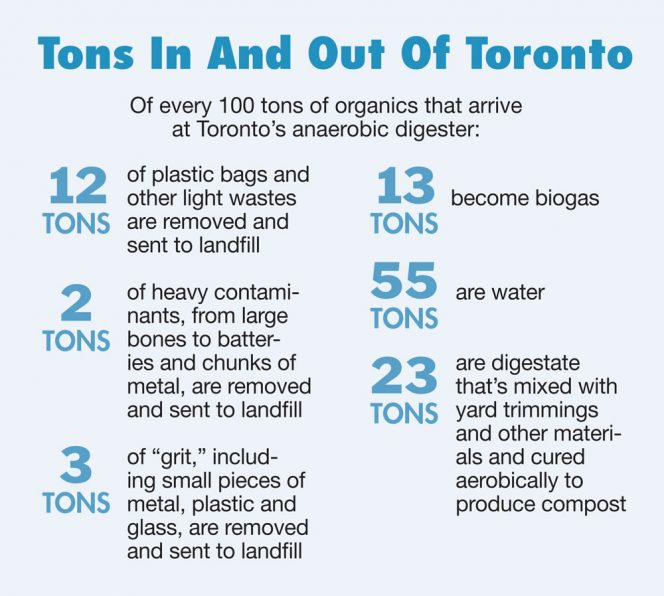Almost 160,000 tons of source separated organics were collected for anaerobic digestion and/or composting in 2016. About 78% came from households.
Peter Gorrie
BioCycle August 2017
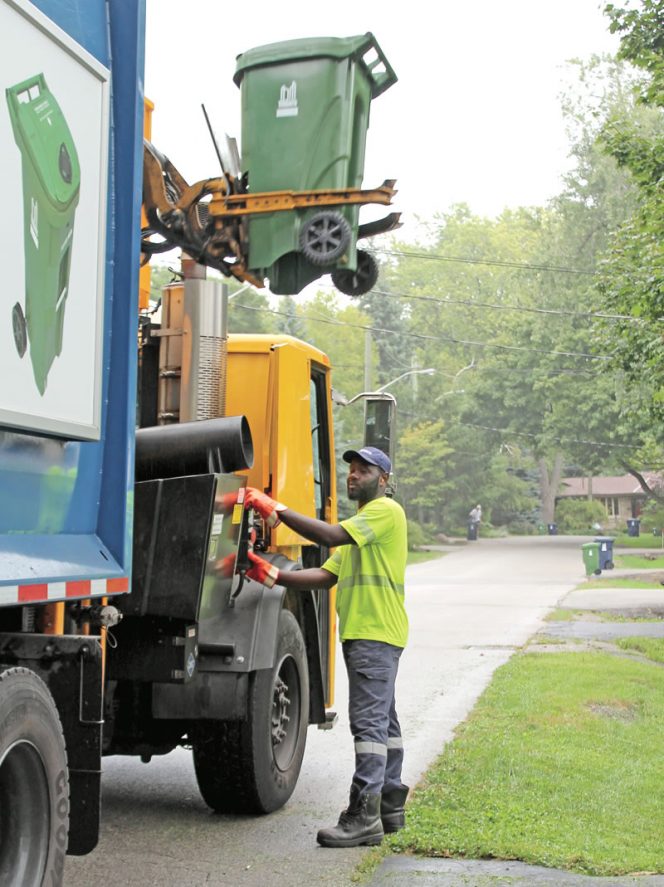
New 26-gallon green bins, purchased in part to combat raccoons that could get into households’ previous carts, are suitable for automated collection. Photo courtesy of City of Toronto Solid Waste Management Services
According to the City’s Solid Waste Management Services, more than 90 percent of Toronto’s 461,000 single-family households (including those that live in apartments above commercial properties) participate in the green bin program, which now also extends to 65 percent of the City’s multifamily residential buildings.
Along with food scraps and food-soiled paper, the organics program, unlike most, accepts pet wastes, kitty litter, diapers and sanitary products. Residents are allowed to package their organics in conventional plastic bags, which are removed and sent to landfill when the feedstock is processed prior to anaerobic digestion. Biodegradable and compostable bags are discouraged since they will be removed before they have time to compost.
Last year, the amount of organics collected averaged 285 lbs/household, with a wide difference between single-family homes, which averaged 449 pounds and residences in the multifamily buildings, at 50 pounds each.
“The City has seen an upward trend in the total amount of food waste collected and processed in its organics diversion program over the last few years,” says Jim McKay, General Manager of Solid Waste Management Services. “This is a positive indication that the program continues to be successful, which will yield various significant environmental benefits.”
Participation is compulsory, and organics are collected weekly. Garbage and recycling are collected every two weeks, on an alternating schedule. Yard trimmings are not permitted: They are picked up in separate biweekly collections from March to December, with a special Christmas tree collection in January.
The City contracts vendors to collect from about 65 percent of Toronto’s multiunit residential buildings. They primarily have their garbage collected weekly. The other 30 percent hire private contractors of their choosing. No data are available about those buildings’ diversion, nor does the City know whether they have some sort of organics waste collection.
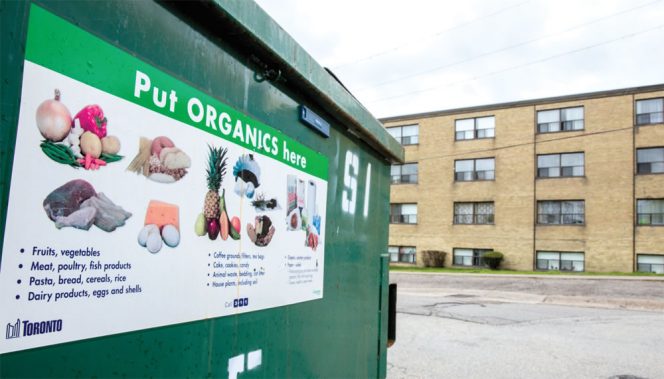
Source separated organics collection is available to 65 percent of Toronto’s multifamily residential buildings. Photo courtesy of City of Toronto Solid Waste Management Services
Raccoon Resistant Bins
Toronto, Ontario’s capital, with a human population of 2.8 million, is home to an estimated 100,000 raccoons. The new green bins were needed because, as Mayor John Tory noted when they were unveiled, with the old bins, raccoons “literally sit around on people’s porches waiting for a buffet” of organic waste. The previous bin featured a latch they could open or that popped if they knocked it on its side.
Residents lock the new version, made by Rehrig Pacific Company under a $31 million (Cdn) contract with the City, by turning a circular dial on the lid to either the 12 or six o’clock position, and they unlock it at three or nine o’clock. Since raccoons lack opposable thumbs, they can’t turn the dial. This means the new bins may be safely stored outside and set out the night before collection.
Unlike the previous version, the bins are also suitable for automated collection. The lid opens when a collection truck’s automatic lift arm lifts and tilts the bin to 110 degrees. It locks again when set back on the ground. The wheeled bins are easy to move and large enough, at 26 gallons — twice the size of the bins they replace — so that almost all households will need only one.
The contract with Rehrig includes 10 years of maintenance and damaged bins will be replaced free to the resident during that period. More than 300,000 new bins have been delivered to single-family homes and townhouses since April 2016. Distribution of the final 180,000 is to be completed by the end of this year.
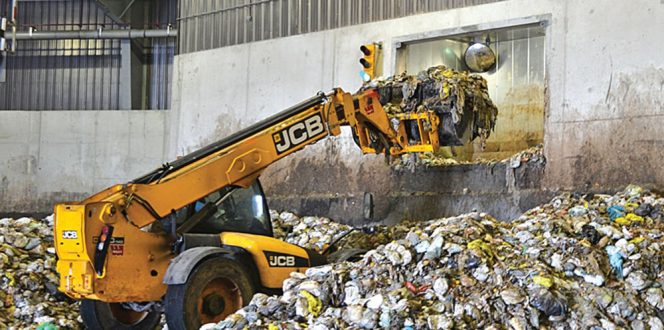
Residents are allowed to package their organics in conventional plastic bags, which are removed when the feedstock is processed prior to anaerobic digestion (above, on tip floor at Disco facility). Photo courtesy of City of Toronto Solid Waste Management Services
AD Processing Infrastructure
Redevelopment of the City’s first anaerobic digester, the 14-year-old Dufferin Organics Processing Facility, is scheduled for completion by November 2018. It will more than double the digester’s annual capacity to 60,000 tons of feedstock. Among the retrofits is installation of Anaergia’s BIOREX pretreatment equipment, which features an extrusion system. After going through a bag shredder and filter, the feedstock is loaded into a perforated steel box equipped with a heavy ram. Pressure from the ram squeezes the relatively compressible organics through the holes in the box while most of the unwanted materials remain, to be disposed in a landfill.
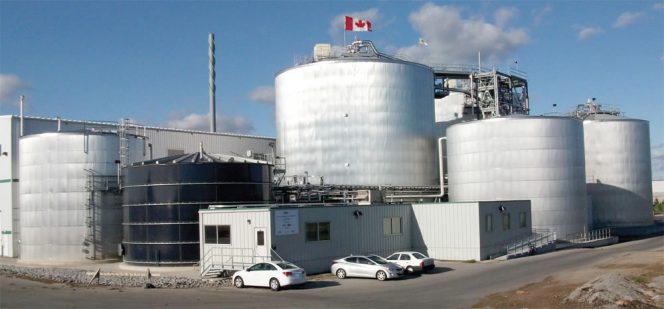
The 83,000 tons/year Disco Road Organics Processing Facility (OPF) went into operation in 2014. The original Dufferin OPF digester is being redeveloped and will have capacity of 60,000 tons/year.
Digestate from Disco is trucked to All Treat Farms Ltd., in Arthur, Ontario, where it is mixed with leaves and yard trimmings and aerobically processed into high quality compost. Digestate from the Dufferin facility will also be sent to All Treat as well.
Over the course of a year about 10 percent of the biogas produced at Disco is used to fuel boilers that provide heat for the digester tank. Currently, the City is examining converting the biogas from both Disco and Dufferin into biomethane, or renewable natural gas (RNG), which could then be injected directly into existing natural gas infrastructure. Once in the pipeline, the RNG can be used to provide heat for homes, generate electricity, or be used as an alternative fuel. Using RNG as a fuel for the City’s own collection vehicles would represent a unique closed carbon loop, as the organics collected by the trucks are the same that are then processed to create the RNG, which is then used to refuel the trucks. This reduces emissions by between 90 and 120 percent compared to using diesel fuel, thereby contributing to Toronto’s carbon reduction targets.
Food Waste Reduction Strategy
In July 2016, Toronto City Council endorsed a Long-Term Waste Management Strategy that is intended to guide policy decisions for the next 30 to 50 years. It includes a Food Waste Reduction Strategy to communicate the value of food and food waste and to educate residents about the benefits of food waste reduction. The aim is to reduce the amount of avoidable food waste going into the Green Bin program, thereby reducing the need for new organics processing infrastructure. It should also reduce the amount of unavoidable (no longer edible) food waste in the garbage stream, in turn, cutting the quantity of garbage to be managed; and supporting consumer participation in sustainable food systems.
The Food Waste Reduction Strategy planning and implementation is underway and will continue through 2026. The City’s Solid Waste Management Services is collaborating with internal and external partners to develop programs and campaigns, which might include incorporating food waste reduction messaging into education materials on community composting and household food preparation, as well as the food handling certification process.
Toronto has been a North American leader in organics recycling since launching its program in 2002. Last year, collections from all residences, schools, City divisions, agencies and corporations and commercial sources totalled 158,962 tons. More than 124,000 tons of that total came from households.
Peter Gorrie is a Contributing Editor to BioCycle.



